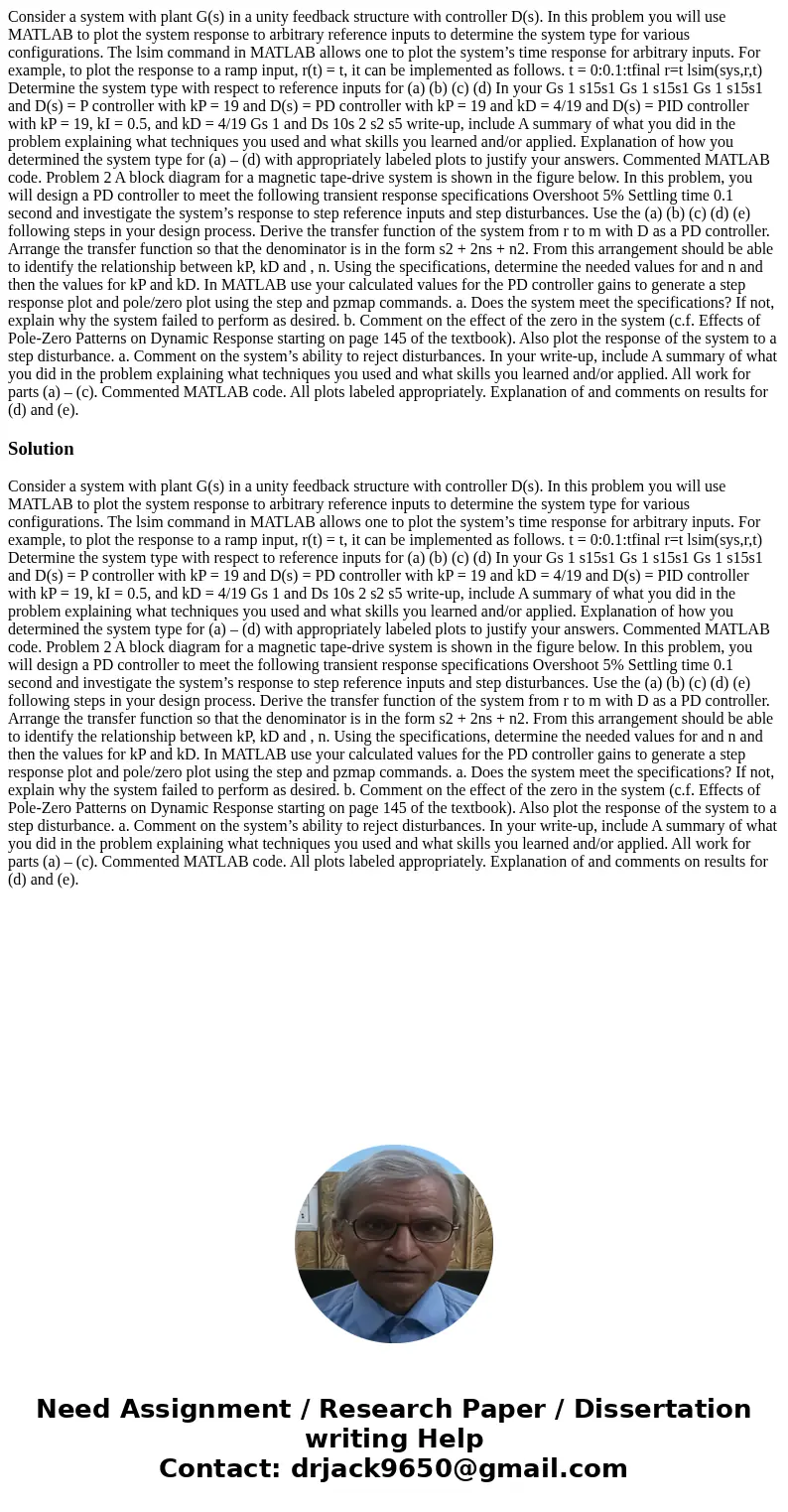Consider a system with plant Gs in a unity feedback structur
Consider a system with plant G(s) in a unity feedback structure with controller D(s). In this problem you will use MATLAB to plot the system response to arbitrary reference inputs to determine the system type for various configurations. The lsim command in MATLAB allows one to plot the system’s time response for arbitrary inputs. For example, to plot the response to a ramp input, r(t) = t, it can be implemented as follows. t = 0:0.1:tfinal r=t lsim(sys,r,t) Determine the system type with respect to reference inputs for (a) (b) (c) (d) In your Gs 1 s15s1 Gs 1 s15s1 Gs 1 s15s1 and D(s) = P controller with kP = 19 and D(s) = PD controller with kP = 19 and kD = 4/19 and D(s) = PID controller with kP = 19, kI = 0.5, and kD = 4/19 Gs 1 and Ds 10s 2 s2 s5 write-up, include A summary of what you did in the problem explaining what techniques you used and what skills you learned and/or applied. Explanation of how you determined the system type for (a) – (d) with appropriately labeled plots to justify your answers. Commented MATLAB code. Problem 2 A block diagram for a magnetic tape-drive system is shown in the figure below. In this problem, you will design a PD controller to meet the following transient response specifications Overshoot 5% Settling time 0.1 second and investigate the system’s response to step reference inputs and step disturbances. Use the (a) (b) (c) (d) (e) following steps in your design process. Derive the transfer function of the system from r to m with D as a PD controller. Arrange the transfer function so that the denominator is in the form s2 + 2ns + n2. From this arrangement should be able to identify the relationship between kP, kD and , n. Using the specifications, determine the needed values for and n and then the values for kP and kD. In MATLAB use your calculated values for the PD controller gains to generate a step response plot and pole/zero plot using the step and pzmap commands. a. Does the system meet the specifications? If not, explain why the system failed to perform as desired. b. Comment on the effect of the zero in the system (c.f. Effects of Pole-Zero Patterns on Dynamic Response starting on page 145 of the textbook). Also plot the response of the system to a step disturbance. a. Comment on the system’s ability to reject disturbances. In your write-up, include A summary of what you did in the problem explaining what techniques you used and what skills you learned and/or applied. All work for parts (a) – (c). Commented MATLAB code. All plots labeled appropriately. Explanation of and comments on results for (d) and (e).
Solution
Consider a system with plant G(s) in a unity feedback structure with controller D(s). In this problem you will use MATLAB to plot the system response to arbitrary reference inputs to determine the system type for various configurations. The lsim command in MATLAB allows one to plot the system’s time response for arbitrary inputs. For example, to plot the response to a ramp input, r(t) = t, it can be implemented as follows. t = 0:0.1:tfinal r=t lsim(sys,r,t) Determine the system type with respect to reference inputs for (a) (b) (c) (d) In your Gs 1 s15s1 Gs 1 s15s1 Gs 1 s15s1 and D(s) = P controller with kP = 19 and D(s) = PD controller with kP = 19 and kD = 4/19 and D(s) = PID controller with kP = 19, kI = 0.5, and kD = 4/19 Gs 1 and Ds 10s 2 s2 s5 write-up, include A summary of what you did in the problem explaining what techniques you used and what skills you learned and/or applied. Explanation of how you determined the system type for (a) – (d) with appropriately labeled plots to justify your answers. Commented MATLAB code. Problem 2 A block diagram for a magnetic tape-drive system is shown in the figure below. In this problem, you will design a PD controller to meet the following transient response specifications Overshoot 5% Settling time 0.1 second and investigate the system’s response to step reference inputs and step disturbances. Use the (a) (b) (c) (d) (e) following steps in your design process. Derive the transfer function of the system from r to m with D as a PD controller. Arrange the transfer function so that the denominator is in the form s2 + 2ns + n2. From this arrangement should be able to identify the relationship between kP, kD and , n. Using the specifications, determine the needed values for and n and then the values for kP and kD. In MATLAB use your calculated values for the PD controller gains to generate a step response plot and pole/zero plot using the step and pzmap commands. a. Does the system meet the specifications? If not, explain why the system failed to perform as desired. b. Comment on the effect of the zero in the system (c.f. Effects of Pole-Zero Patterns on Dynamic Response starting on page 145 of the textbook). Also plot the response of the system to a step disturbance. a. Comment on the system’s ability to reject disturbances. In your write-up, include A summary of what you did in the problem explaining what techniques you used and what skills you learned and/or applied. All work for parts (a) – (c). Commented MATLAB code. All plots labeled appropriately. Explanation of and comments on results for (d) and (e).

 Homework Sourse
Homework Sourse